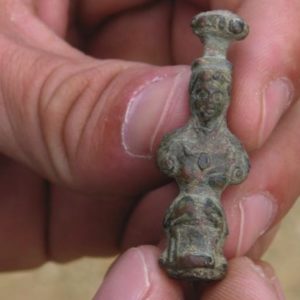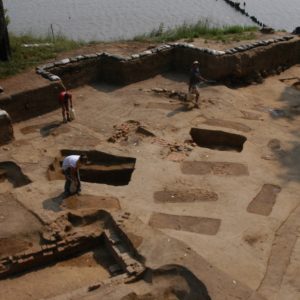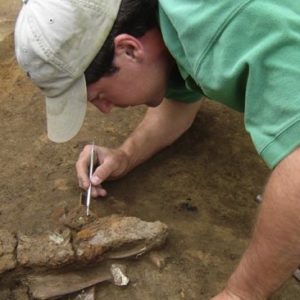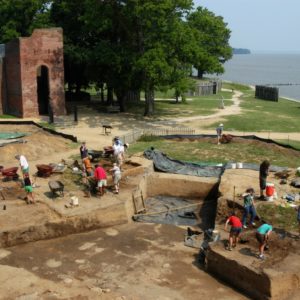The 2005 field school has begun and the Jamestown Rediscovery archaeologists now have 19 student-archaeologists who are working with them to excavate James Fort. Under the guidance of the full-time crew, the field school archaeologists are busily digging near the center of the fort in the hope of finding the original church. Prior to the arrival of the field school students, archaeologists had found a number of building postholes near the center of the fort. Having only dug a limited area of the fort’s center, it has been hard to tell how many buildings these postholes indicate. This summer’s digging will hopefully yield many more postholes to help the archaeologists piece together the nature and quantity of these buildings.
Inside the western palisade wall archaeologists have discovered four pit features where numerous artifacts have been found. Though the nature of these pits is uncertain, some of them could have possibly been small cellars for lean-to type structures, while others may have been sources of clay for use by the colonists. It seems that once they had outgrown their original purpose they may have been used as trash pits, thus holding a large array of interesting artifacts from the fort period.
In the pit closest to the western bulwark, part of a brigandine–a jacket of armor made of iron plates bound by copper rivets–has been found. Another pit yielded a jack of plate, as well as the top of a powder flask that would have been used to dispense gunpowder. A third pit contained the stem of a Native pipe, and a turkey bone that may have been used as a tool. In the pit furthest from the western bulwark a Swedish silver coin was found which dates to 1576. Nearby in the same pit, pieces of German stoneware as well as an English Midlands Purple Butter Pot were found.
More digging in the Confederate Fort area has uncovered a larger part of a Confederate gun platform designed to defend the area from Union naval advances. Seventeenth-century unused window lead was recently found in this area. This lead was used as a frame between the many pieces of glass that made up the windows of the period. A finial in the form of a classical figure thought to originate from the 17th century was also found in this area.
Near the western bulwark and inside the western palisade wall a series of 22 burials has been found. Due to the style of the burials these are believed to be English. It is also thought that these burials are from a very early period in the colony’s history because they are arranged in a manner that respects the presence of the western palisade wall. Some of the graves also were cut through by a cobblestone building thought to have been built in the second decade of the 17th century. This is solid evidence that the graves were there before the building was built.
related images
- Finial in the form of a classical figure found in the Confederate fort area
- Burials within the western palisade wall
- Archaeologist Carter Hudgins excavates brigandine armor
- Field school participants digging near the center of the fort









